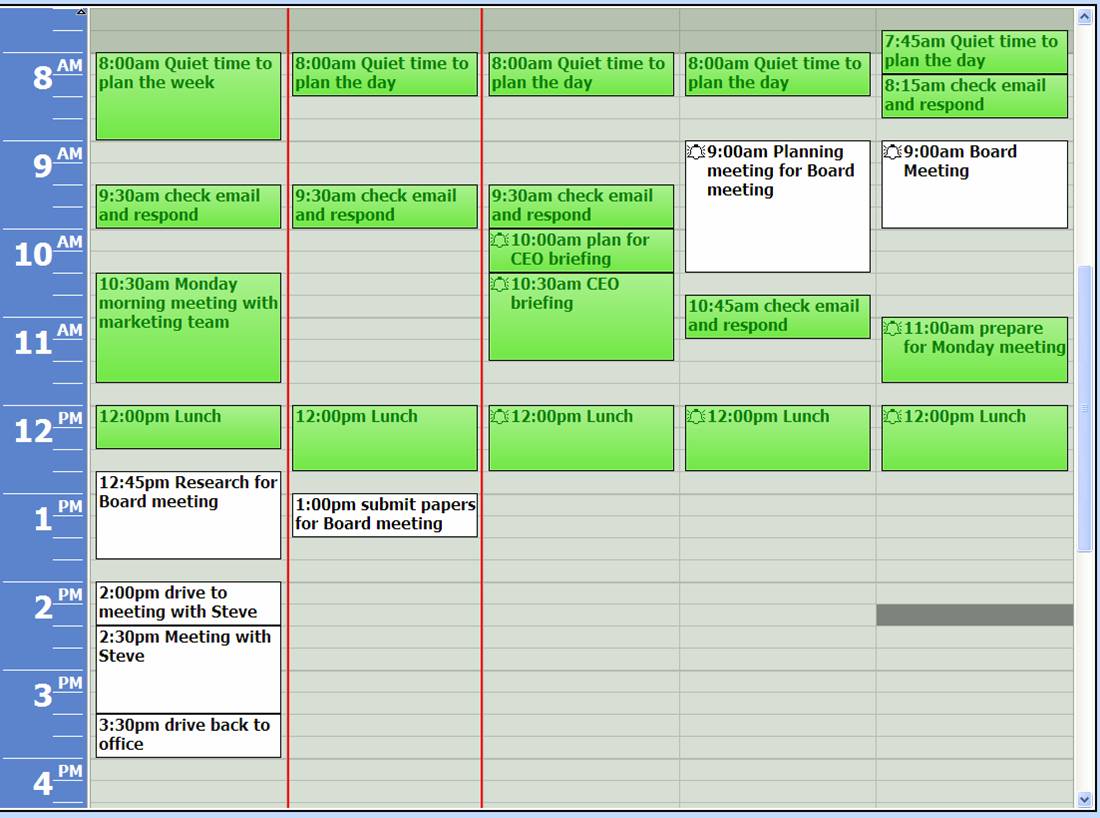Many professionals only maintain lists of items to do, and don’t actually schedule anything other than appointments into their calendars. In the language of 2Time, they may be Green Belts at the skill of Listing, but Yellow Belts at the skill of Scheduling.
A typical professional’s schedule is below – let’s say his name is “Sam”. He is attending both meetings with Bob, his boss.
Sam’s Schedule
Why can this approach create a problem? After all, most of the time management systems that exist only address using the schedule in a basic way. GTD® takes it another step and advocates the scheduling of “contexts”, or in other words groups of activities such as:
- @home
- @computer
- @meeting with Bob
- @driving
These are pretty basic appointments that one has with oneself. Incidentally, I have noticed that there is no word in the English language for “an appointment with oneself”. At different times in this blog, I have used different words to describe the whole genre of scheduled activities, including both appointments with others as well as oneself. In this post, I’ll use the word “engagement”.
The problem with only having a list (or lists) of activities is a simple one – it is too easy for a list to grow out of proportion to the time that one has available when it’s not scheduled into a calendar.
For example, I may easily schedule 1 or 4 or 55 items in a list that must be accomplished when I am next at my computer, but mistakenly only schedule one hour to get them all done. In other words, there is no way to balance what is on that list with the time I have available, except when I am actually at my computer. By then, its too late. Even if I sit down each evening and plan the following day based on what it is on my list, I am still making a crude approximation of the time needed to complete important tasks.
Instead, the truth is that most professionals follow more or less the same routine each day. In fact, they don’t change their schedule much from day to day (if it’s under their control). Regardless of where they are in the world, they must still do some of the basics, and their schedule must be shaped around these basic engagements that must be scheduled within each day. Once these basics are in the calendar, appointments with others can be added, which then leaves time for solo engagements.
The most skilled users of their calendars use their lists sparingly, and instead prefer to schedule their activities into the their calendars directly, thereby dealing with the fact that each and every engagement takes time, and the best time to decide when to tackle a task is in conjunction with the other tasks that are competing with it for valuable time. This is better done beforehand, well ahead of the moment, rather than at the start of a block of time such as “time at my computer”.
Here is what a calendar might look like that is designed in this way. This is Bob’s calendar, and as I mentioned before, he is attending the same 2 meetings as Sam, whose calendar was presented before.
Notice that there are lots of recurring items scheduled (they are all in green). Notice also that Bob has scheduled time to prepare for the meetings that Sam will be in. He has prepared himself in very specific ways to accomplish his goals by scheduling them as engagements.
If the engagements need to moved around, it is easy for them to be rescheduled within this week or to a different week. If they need to be canceled, then that is easy also.
This kind of schedule makes it much less likely to over-commit oneself. When Bob’s boss asks “Can you finish the project by Thursday at 3pm?”, there is no guess-work involved as to what work is on the list of items to be done on Thursday morning’s “at my computer” list. Instead, the engagements are clearly laid out, and can be moved around with the full knowledge of what he is doing or not, and when he is taking action, or not.
As said in other places in this blog, I neither recommend the use of schedules in this, nor recommend against them. Each user must make up their own mind as to what fits their habit pattern.
However, it’s a useful to thing to know that the technique exists, and that it can be used to increase one’s productivity IF the skill can be mastered.



